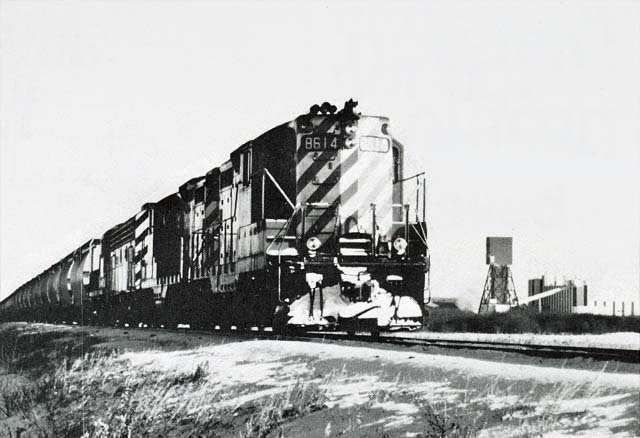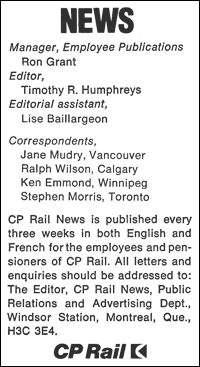|
|
Volume 13
Number 2 January 26, 1983 |

|
Spurs Rail Innovations
By KEN EMMOND

WINNIPEG - CP Rail has responded to dwindling potash movements in 1982 with innovative routings, competitive rate structures, and growing numbers of unit trains for increased efficiency.
As a result, the volume of potash moving through the port of Thunder Bay actually went up, while the proportion of potash moving into the Midwestern United States by rail and barge rather than by truck is expected to show a marked improvement in 1983.
"The worldwide recession is forcing shippers from countries as far away as Israel and Eastern Europe to become more and more competitive in the North American markets," said Ken Schoor, marketing manager for potash here.
FLEXIBLE
"We have to be flexible with our rates and innovative with our methods if we are to help Saskatchewan producers remain in this extremely competitive arena. Even a few cents in price at the destination can make the difference between success and failure."
In Thunder Bay, where potash is off-loaded from railcars to lake vessels, an estimated 1.1 million tons (1 million metric tons) moved through the facility operated by Thunder Bay Terminals Ltd.
That's 400,000 tons (362,880 metric tons) more than moved through in 1981, the facility's first year as a potash handler. The increase nudged total potash movements through Thunder Bay to about 1.8 million tons (1.6 million metric tons) up from 1.6 million tons (1.5 million metric tons) the previous year.
In 1978, just 225,000 tons (204,000 metric tons), less than three percent of Saskatchewan's shipments to North American markets, moved through Thunder Bay. The rest was shipped by rail or truck directly to market.
BREAKTHROUGH
This year, one out of every five tons shipped southeast from Saskatchewan mines moved through Thunder Bay.
Most of the potash goes to such Great Lakes ports as Toledo, Burns Harbor, and Milwaukee in the U.S., and Port Stanley, Ontario, in Canada, but the Thunder Bay Terminals facility, with its 27-foot (8.2-metre) draught, has loaded vessels destined to Baltimore, Maryland, USA, and More-heat City, North Carolina, USA, demonstrating its ability to serve vessels bound for the Eastern Seaboard or overseas.
The dock can accommodate a vessel loading to more than 30,000 tons (27,216 metric tons), measuring up to 750 feet (228 metres) long, and can load at a rate of 1,700 to 2,000 tons (1,542 to 1,814 metric tons) per hour.
Though the one million ton season at Thunder Bay was CP Rail's most spectacular breakthrough in the 1982 potash market, two other developments hold promise for the year ahead.
In October, the railway, in cooperation with the Soo Line, began shipping unit trains of potash from Saskatchewan 300 to 500 miles (500 to 800 kilometres) to the border at Emerson, Manitoba, and then another 400 miles (640 kilometres) to Minneapolis, Minnesota, USA.
There, the product was off-loaded onto Mississippi River barges and transported to downstream destinations for further distribution by rail or truck.
By the time the season ended in early December, an estimated 120,000 tons (109,000 metric tons) had moved by this route.
To extend the movement into a year-round affair, CP Rail developed a variation on the Minneapolis routing, moving via the Soo Line to Chicago and then over the Missouri Pacific Railroad to St. Louis, a year-round Mississippi River port.
By the end of December, an estimated 50,000 tons (48,000 metric tons) will have travelled the 1,500 miles (2,500 kilometres) or so by train to St. Louis. The route will be used until the Minneapolis terminals reopen, probably in April.
REDUCED RATES
The trainload method of moving potash allows CP Rail to reduce the rail rates by up to 30 percent, and permits potash shippers real savings and efficiencies.
Earlier this year, the railway moved to meet competition from truckers by reducing rail rates to points in Minnesota, Wisconsin, Western Canada, and the U.S. Northwest. Rate reductions of up to $10 a ton enabled shippers to retain rail delivery at competitive prices.
In addition, CP Rail introduced a two-way haul between Saskatchewan and the U.S. Midwest, with potash moving south and other products, including soybean meal, moving north to Saskatchewan.
There are seven potash mining companies active in Saskatchewan at present, Potash Corporation of Saskatchewan, International Minerals and Chemical Corporation, Kalium Chemicals, Cominco Ltd., Potash Company of America, Central Canada Potash, and Kidd Creek Mines Ltd.

